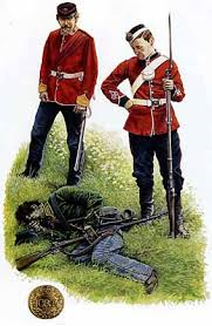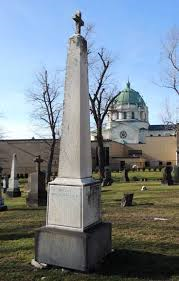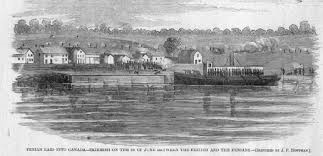 Artist's Impression of slain Fenian
Artist's Impression of slain Fenian As previously noted in this blog, the first Fenian casualty in the 1866 invasion was a friendly fire incident at the Frenchman's Creek bivouac on the evening of June 1, 1866. The unnamed soldier, who was heard to declaim that he was 'sick of the whole business' and sure he was not going any farther on such a fool's errand, was found dead in the underbrush a day later. One source says he was mistaken for a British soldier and shot by sentinels, and another that he was shot by accident.
The next nine occurred at the Battle of Ridgeway June 2, 1866.
A period map shows that the first, probably a skirmisher, was killed a few hundred yards east of the Ridge Road on land that appears to have belonged to farmer Henry Teal. The next casualty occurred a hundred yards west of the Fenian picket just south of Bertie Road probably in Ervin Ellsworth's orchard. Four more died on land owned by the Angers and Jacob Rinehart, slightly north and west of Ridge/Bertie Roads, where by period accounts "the real battle was fought." O'Neill had placed fence rails in a slanting position as a barricade and thus had the advantage of cover while the Canadians fought in the open. The Canadians, even despite their apparent terrain disadvantage, and the fact that they were volunteers without any previous battle experience, still were able to inflict the greater losses. General O'Neill offered the following tribute, "I have never seen inexperienced troops fight more gallantly than those Canadians. It is just what I might have known though. You see I know the breed." Two more Fenians fell in the general vicinity of Ridge and Bertie Roads.
One Fenian officer died on the field at Ridgeway from self-inflicted wounds after a rash act of retribution. Canadian Private R. W. Hines of No. 8 Company Queen's Own Rifles had been taken prisoner by a squad of Fenians, his rifle removed from him and handed to one of their officers. The officer took the rifle and, after eyeing it critically, grabbed it by the barrel and with a profane remark that it would never shoot another Fenian, smashed the stock against a boulder. The Canadian gun, being loaded and at full cock went off with the concussion, and the bullet passed through the Fenian's body killing him instantly.
John Vanderburgh of Allanburg (Thorold) Ontario, had come to the battlefield to observe "and when I got there," he relates, "the battle was just over. I walked down to the battleground and they had all left, and I walked around the battleround and found two dead Fenians lying on the ground, (one) of them had been shot in the stomach and one of his socks was shoved partly in the hole to stop the blood." Vandenburgh is describing one of the great fears of the 19th century soldier: that of being 'gut shot'. The Minie ball ammunition would tear a large hole through the body, and after a minute of numbness, severe pain would set in as the intestines bld into the abdomen, and the victim would die a slow and agonizing death.
Dr. Brewster of Ridgeway cared for the wounded on the field, and observed in 1911, "I have never seen the Fenian loss reported, but I found four of their dead, and learned from people living on those roads (Ridge/Garrison) that at least six waggons carrying dead and wounded were seen going toward Fort Erie."
Six of the Fenians were buried by Bertie farmer Jacob Steinman in one grave in a bush between the John Anger house and the property owned by William Teal, just west of Ridge Road. Two more were buried close to Ridge Road, one in an orchard close to the camp, (probably James Gerahty of Cincinnati- see list below), another in front of a house.
Andrew Benner of Ridgeway, who had followed the Canadian troops to the battleground, and had witnessed nearly all of the battle, tells of the following incident related to the burials. A big Irishman came looking for his son, who, as he put it, did not come back. "We du up the six" stated Benner, "then the one in our orchard, and I am sorry I cannot say if he found him, as I did not go to the last place with him." However, Benner does go on to say that he had heard from another source that the father had recognized his son's shoes on the feet of the man he hired to disinter the body, and made him point out the spot where the boy was buried, and accordingly, found him in the eighth grave.
It is unlikely that any of the eight are still in their battleground resting places. Jacob Steinman, who knew the location of every grave, was visited often in the years afterward
by medical doctors and students who asked to be shown the grave sites. One American doctor openly professed to wanting to procure a skeleton, but when Steinman searched the graves that he had dug, none were found..
A number of years ago, human skulls and bones were unearthed on a farm on Bertie Road by a man digging a gravel pit. The farm was located on part of the Ridgeway battlefield, and some conjecture followed that they may have been from the period when the battle occurred.
Nine Fenian casualties at the Battle of Ridgeway have been identified.
Pat Buckley- 18th Regiment Cleveland Ohio. No rank given.
Seriously wounded on field at Ridgeway. Taken to St. Catharines. Did not recover from wounds. His relatives removed his body from Fort Erie and transferred it to Buffalo on June 14, 1866 under the direction of Timothy Crowley, the Buffalo undertaker.
Major John C. Canty- 7th Regiment Buffalo, Chief Intelligence Officer.
An employee of the Grand Trunk Railway, Candy had lived in Fort Erie since 1865, bought a house there, and operated as a Fenian spy; supplying maps and intelligence regarding militia troop strength and movements. Eventually buried at Holy Cross Cemetery, Lackawana.
Michael Cochrane- Colour Sergeant- Captain Hugh Haggerty's Independent Company from Terre Haute Indiana.
A thirty-four year old Irish Catholic, by period accounts seriously wounded on the field at Ridgeway in the final charge. Taken to St. Catharines along with Pat Buckley. Did not recover from wounds.
James Gerahty- 18th Regiment Cincinnati Ohio.
Seriously wounded and left on the field. Taken to a makeshift hospital on Ridge Road. A correspondent from Toronto 'Leader' describes his final moments: At the same time a Fenian was brought in on a stretcher in a dying state. I ordered his comrades to cut his shirt open, when I found an ugly wound under his left arm, which I have no doubt penetrated a vital part. I got water and washed the wound; he was sensible and able to tell me that his name was James Gerrahty from Cincinnati, and that one of his comrades had shot him by mistake, and that he freely forgave him. He died in about thirteen minutes, one of his comrades holding a crucifix before him as long as he could see it. We buried him in an orchard adjoining the same evening.
Edward Lonergan- Lieutenant 7th Regiment Buffalo
A ship's carpenter from Buffalo's first ward, who worked at the Jones Ship Yard. Died on the field at Ridgeway on his 21st birthday. Lonergan's body had been taken by his fellow Fenians back to Fort Erie in the afternoon of June 2 and left in the barn at Major Canty's house. Initially he was buried along with several other Fenians in a pit dug below the hill overlooking Fort Erie (perhaps the gravel pit that was near Gilmore Road). His family however, came from Buffalo, and petitioned Col. Lowry, the Canadian Commander, to have him disinterred. Buffalo newspaper accounts of the day raised a tumult concerning the condition of the body.
Col. Lowry responded in a letter to the paper that he was "shocked by the assertions that indignities had been practiced upon the dead Fenians." " I ordered burial of the dead" he wrote, "and enquiries which I have now made, in the fullest detail possible, under the circumstances of which I am pleased, satisfy me that they have suffered no indignity whatever. Some of the bodies have been disinterred and in no case have the friends of the dead found cause for complaint or expressed any."
By way of rebuttal, Colonel John Hoy of the 7th New York Regiment, Buffalo, a Fenian commander present at Ridgeway, wrote to the newspapers on June 11, 1866 concerning this matter.
"Having read in your paper of the 9th inst. a letter by Col. Lowry commander of the British forces at Fort Erie, wherein he states that no indignities had been offered to our dead, I will state and can substantiate what I say by the sworn affidavits of the friends and relations of Lt. Lonergan of my command, that not only were his remains horribly mutilated but (indecipherable) the boots and stockings were pulled off him, and furthermore that when the British soldiers went to bury him they dragged him to the grave by the hair of his head as though he were a dog they were burying."
The body of Lt. Lonergan had been disinterred on June 4, 1866 and returned to Holy Cross Cemetery for reburial by Buffalo undertaker Thomas Crowley.
John Lynch, Sergeant 18th Regiment Cleveland Ohio
Died of wounds received at Ridgeway while in Sisters of Charity Hospital Buffalo on 27th July 1867. Buried at Holy Cross Cemetery Lackawanna on July 29, 1867.
John Lynch, Private 18th Regiment Cleveland
Originally from Cincinnati; shot in the thigh, treated at the Erie and Niagara Railway House but removed to Buffalo and died of his wound June 11, 1866. Body shipped to Cleveland by Thomas Crowley, the Buffalo undertaker.
Thomas Rafferty- 18th Regiment Cincinnati
Mortally wounded in the stomach at Ridgeway. No further confirmation.
Note: Albert W. Reavley, a gunner in the Welland Canal Field Battery observed a Fenian fall during the final push back into Ridgeway. A "fine big strapping fellow...came jumping over a wall" he relates. A Scotman standing next to Reavley drew a bead and fired. The Fenian dropped, a bullet through his stomach. "I faxed that un" the Scotsman said.
Edward (Richard?) Scully No rank given: 18th Regiment Cleveland Ohio.
Died in Buffalo 9/10 June from wounds received at Ridgeway. The body was shipped to his home town of Cincinnati the next day. His remains were escorted to the train depot by about 650 men, most of them from Ohio, accompanied by a band of music.
Died of wounds received at Ridgeway while in Sisters of Charity Hospital Buffalo on 27th July 1867. Buried at Holy Cross Cemetery Lackawanna on July 29, 1867.
John Lynch, Private 18th Regiment Cleveland
Originally from Cincinnati; shot in the thigh, treated at the Erie and Niagara Railway House but removed to Buffalo and died of his wound June 11, 1866. Body shipped to Cleveland by Thomas Crowley, the Buffalo undertaker.
Thomas Rafferty- 18th Regiment Cincinnati
Mortally wounded in the stomach at Ridgeway. No further confirmation.
Note: Albert W. Reavley, a gunner in the Welland Canal Field Battery observed a Fenian fall during the final push back into Ridgeway. A "fine big strapping fellow...came jumping over a wall" he relates. A Scotman standing next to Reavley drew a bead and fired. The Fenian dropped, a bullet through his stomach. "I faxed that un" the Scotsman said.
Edward (Richard?) Scully No rank given: 18th Regiment Cleveland Ohio.
Died in Buffalo 9/10 June from wounds received at Ridgeway. The body was shipped to his home town of Cincinnati the next day. His remains were escorted to the train depot by about 650 men, most of them from Ohio, accompanied by a band of music.
A minimum of four casualties, possibly five, occurred during the Skirmish at the Fort Erie Docks on the afternoon of June 2, 1866.
Lt. Col. Dennis writes to Col. Lowry
"The enemy suffered more severely. Three of his number were killed outright and four were mortally wounded, two of whom died yesterday morning, the other two had been allowed, under the circumstances, by the Reeve Dr. Kempson, with the permission as I understtod of Col. Lowry, to be taken to the Buffalo hospital."
Lt. Col. Dennis writes to Col. Lowry
"The enemy suffered more severely. Three of his number were killed outright and four were mortally wounded, two of whom died yesterday morning, the other two had been allowed, under the circumstances, by the Reeve Dr. Kempson, with the permission as I understtod of Col. Lowry, to be taken to the Buffalo hospital."


 RSS Feed
RSS Feed